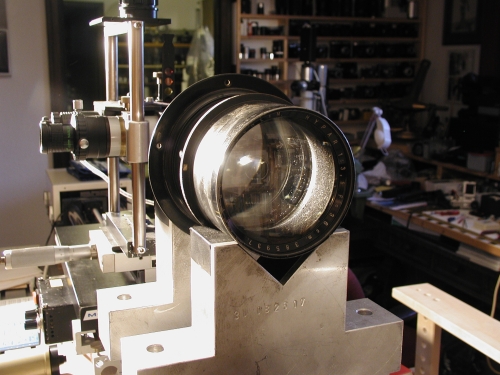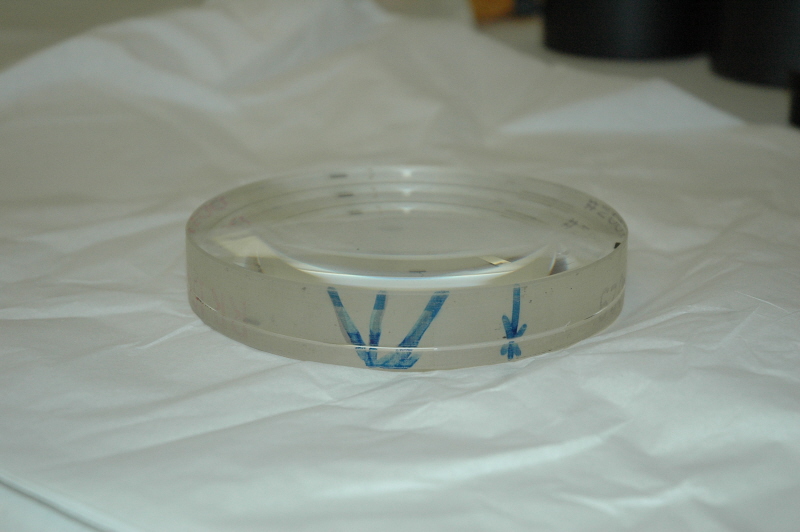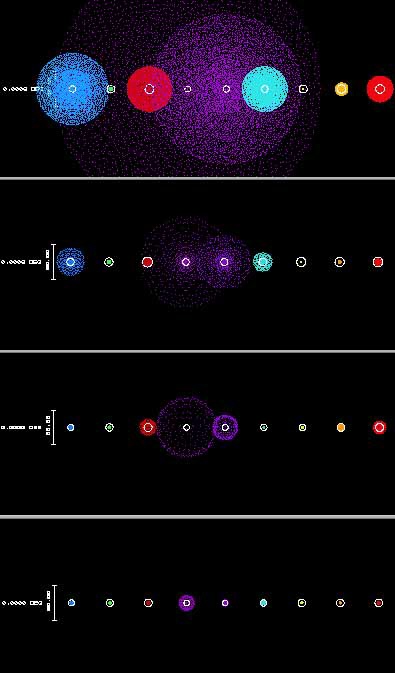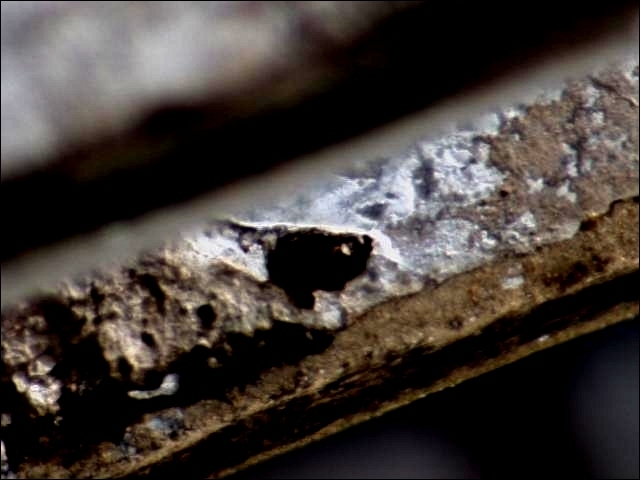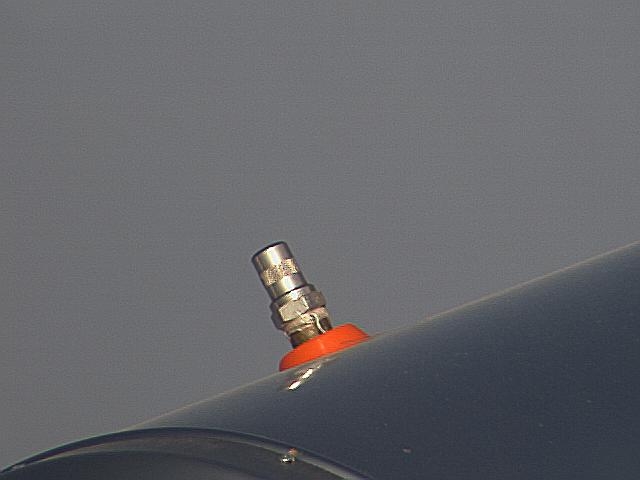
DBAROUNIS
Μέλη-
Αναρτήσεις
14 -
Εντάχθηκε
-
Τελευταία επίσκεψη
Σχετικά με DBAROUNIS
- Γενέθλια 11/24/1968
του/της DBAROUNIS Επιτεύγματα
-
Αχρωματικό διοπτρικό με Chromacor.
DBAROUNIS απάντησε στην συζήτηση του/της Efstathios σε Τηλεσκόπια
substitute δεν ειναι. Δειτε το κειμενο του T. Back Defining apochromatism.... Ρωτω και εγω αν πραγματικα η ευρεια κοινοτητα γνωριζει τι ειναι αποχρωματικο. Μηπως ενα διοπτρικο με λευκα fuzzy ειδωλα. Με τον κατασκευαστη δεν εχω καμμια εμπορικη σχεση ουτε προσπαθω να πουλησω το προιον. Για το κατοπτρικο συμφωνω. Επισης διαβαστε στο βιβλιο ΤΗΕ ΕPIC MOON για τον παρατηρητη FAUTH και το θρυλικο διοπτρικο του 15 ιντσων. -
Αχρωματικό διοπτρικό με Chromacor.
DBAROUNIS απάντησε στην συζήτηση του/της Efstathios σε Τηλεσκόπια
Για μια εξαιρετικη απλη και ακριβη μεθοδο μετρησης σφαιρικης και χρωματικης εκτροπης διαβαστε στο SKY AND TELESCOPE - APRIL 2004-E. PHANNENSCHIMDT. -
Αχρωματικό διοπτρικό με Chromacor.
DBAROUNIS απάντησε στην συζήτηση του/της Efstathios σε Τηλεσκόπια
Νομιζω οτι δεν εχει νοημα η συγκριση. Προσωπικα ειμαι πολυ ευχαριστημενος, και δεν διαθετω αλλα χρηματα για τηλεσκοπιο (C8, ETX, και 2 διοπτρικα Vixen ειναι σε αποθυκευση), ενω καποιος αλλος θα δυσκολευτει αρκετα πλεον να κστασκευασει κατι αντιστοιχο. Ελπιζω να καταλαβατε οτι δεν μιλω με αυταρεσκεια απλα ρεαλιστικα. Επιμενω οτι η ουσια στο χομπυ βρισκεται στην ευχαριστηση που αντλει καποιος απο αυτο, σε συνδυασμο βεβαια με την γνωση που αποκτα σταδιακα προχωρωντας. Οπως ξαναειπα μας ενδιαφερει ο ουρανος μονο. Σημ. Το τρεχον project μου αφορα την επαναφορα σε χρηση ενος αποχρωματικου τριπλου αστρογραφου Zeiss-Goerz 360 mm f/3.5 κατασκευης 1916. -
Αχρωματικό διοπτρικό με Chromacor.
DBAROUNIS απάντησε στην συζήτηση του/της Efstathios σε Τηλεσκόπια
Λυπαμαι, θα ειμαι σε διακοπες -
Αχρωματικό διοπτρικό με Chromacor.
DBAROUNIS απάντησε στην συζήτηση του/της Efstathios σε Τηλεσκόπια
μπορει καποιος να χρησιμοποησει και ED (Vixen, Meade, Skywatcher) σαν πλατφορμα -
Αχρωματικό διοπτρικό με Chromacor.
DBAROUNIS απάντησε στην συζήτηση του/της Efstathios σε Τηλεσκόπια
Δειτε στο http://astro.uni-tuebingen.de/~grzy/index.html οτι το performance δεν εξαρταται παντα απο το ΟΝΟΜΑ και το optical concept. Ξαναδιαωαστε παλι το αρθρο του T. Back. Σε καθε περιπτωση στο χομπυ μας επιθυμητη ειναι η μεγιστοποιηση της χαρας με ελαχιστοποιηση του κοστους. Χαρειτε την ΝΥΧΤΑ, και οχι το ΓΥΑΛΙ. Ευχαριστω! -
Αχρωματικό διοπτρικό με Chromacor.
DBAROUNIS απάντησε στην συζήτηση του/της Efstathios σε Τηλεσκόπια
Οπτικο test γινεται πολυ ευκολα με rochi grating με προυποθεση οτι εχει πανω απο 250 γραμμες/ιντσα. Μπορει να το βρει καποιος στο ORION OPTICS (UK). Σχετικα με τρεχουσες τιμες δεν μπορω να δωσω εκτιμηση. Παντως ενα καλα ταιριασμενο συστημα παραμενει εξαιρετικα ανταγωνιστικο εναντι των παραδοσιακοων αποχρωματικών ASTROPHYSICS, TAKAHASHI, TMB με κριτηριο την τιμη -αποδοση. Δειτε στο www.apm-telescopes.de ή στο www.astrotech.it στις ΗΠΑ www.astrobuffet.com αν υπαρχει διαθεσιμο chr2 και καποιο απο τα TMB designed αχρωματικα 6-7 ιντσων. Focusers Baader ή WO υπαρχουν διαθεσιμοι ενω ευκολα μπορει να κατασκευαστει push/pull βαση για το focuser αν και διατιθεται απο το bright-star instruments στη Πορτογαλια. -
Αχρωματικό διοπτρικό με Chromacor.
DBAROUNIS απάντησε στην συζήτηση του/της Efstathios σε Τηλεσκόπια
οντως ενα καλα σεταρισμενο αχρωματικο με chr2 ειναι καλυτερο απο ed. Δωστε εμφαση στο κειμενο το Τ. Back που παραθετω καθως και στα spots diagrams, λογω καλυτερης διορθωσης σφαιρικου, χρωμοσφαιρικου και χρωματικου σφαλματος. Το chr2 κοστιζει usd 750 περιπου αλλα πλεον ειναι δυσευρετο. Επισης υπαρχουν διαβαθμισεις στη σφaιρικη διορθωση που προσφερει, για αυτο πρεπει το σφαιρικο σφαλμα του αντικειμενικου να ειναι γνωστο με ακριβεια. Επισης ο αντικειμενικος δεν πρεπει να εχει κομη, αστιγματισμο και ζωνες σφαλματα που δεν διορθωνονται. Για το λογω αυτο επελεξα φακο RR και οχι Synta. Δειτε την οπτικη αναλυση του αντικειμενικου φακου μου στο αρχειο PDF. Το αρχικο strehl ειναι παρα πολυ καλο (0.95 περιπου) ενω υπαρχει σφαιρικο undercorrection 1/6. To chr2 εχει overcorrection 1/6 οποτε το συνολικο σφαιρικο σφαλμα ειναι μηδεν. Σημαντικος ειναι ο εστιαστης οπου παλι το Synta υστερει. Δειτε το συστημα μου, οπου το θεμα της ευθυγραμμισης λυνεται απλουστατα. Για την πλειονοτητα των χρησεων ενα τετοιο συστημα παραμενει εξαιρετικα ανταγωνιστικο εναντι των κλασσικων αποχρωματικών. Στο χωρο της αστρονομιας ειμαι απο το 1981, με πλειαδα τηλεσκοπιων ενω σε σπουδες ειμαι μαθηματικος με τομεα ουρανια μηχανικη αν και εργαζομαι στο χωρο των επενδυσεων. SCANNER.pdf -
Αχρωματικό διοπτρικό με Chromacor.
DBAROUNIS απάντησε στην συζήτηση του/της Efstathios σε Τηλεσκόπια
Η SYNTA δεν παρεχει κατι αντιστοιχο μια που η συνθεση των κρυσταλλων του chromacor (3 τον αριθμο) ειναι custom απο ARIES και δεν ειναι διαθεσιμη μαζικα. Οπως και το neoachromat Vixen υπαρχει ενας - δυο φακοι στον εστιαστη κατα την αρχη Petzval που παρεχουν ευθυ πεδιο χωρις να επανεστιαζουν το ερυθρο-ιωδες-κυανο της χρωματικής εκτροπης. Δειτε στη σελιδα της ΑΚΤΙΣ για το chromacor τις φωτο μου της σεληνης σε B, R, G. To καναλι Β ειναι εστιασμενο κανονικα. Εκτος της ARIES κατι αντιστοιχο κατασκευασε η ASTROPHYSICS τη δεκαετια του 80 για 2 διοπρικα εννεα ιντσων, ενω στην ιδια αρχη βασιζεται και το διοπτρικο PLOESSL του αστεροσκοπειου της Αθηνας (κατασκευη 1846!!). Ο PLOESSL κατα σκευασε αποκλειστικα τετοια τηλεσκοπια. Διαβαστε σχετικα στο HISTORY OF THE TELESCOPE-HENRY KING-DOVER PUBLICATIONS (ΣΕΛ 191). Παρομοια αρχη εχουν και τα Shupmann Telescopes (με χρηση ομως mangin mirror σαν τα Klevtzov Vixen VMC). Στο συστημα μου η εθυγραμμιση ειναι εξαιρετικα απλη και χωρις προβληματα στις μετακινησεις. Θα χαρω να δωσω οποια αλλη πληροφορία. Το βασικο χαρακτηριστικο είναι η πληρης εστιαση ολων των χρωματων και οχι η αποκοπη τους οπως γινεται με τη χρηση φιλτρων. Επιπλεον το σφαιρικο σφαλμα εκμηδενιζεται οπως και το σφαιροχρωματικο (μεταβολη της σφαιρικης εκτροπης σε συναρτηση του μηκους κυματος). Αποτελεσμα η τελεια λειτουργεια ακομα και σε "ατοπες" μεγενθυσεις 150χ/ιντσα!!! πραγμα που χρησιμοποιω μονο σε δοκιμες. Σχετικα με το ED δειτε τα spot diagrams πιο πανω. Διαβαστε http://www.cloudynights.com/item.php?item_id=18 Δειτε το συστημα εστιασης και τον αντικειμενικο RR. Το διαγωνιο που ενσωματωνει το συστημα ειναι INTES DELUXE και οχι WO, το οποιου το κατοπτρο εχει επιστρωση HILUX ORION OPTICS (UK),ενω το σφιξιμο γινεται με APM SELF CENTERING ADAPTER και οχι με απλη βιδα που δεν παρεχει ομοιομορφη πιεση. Αντιστοιχο συστημα εχουν και οι εστιαστες FeatherTouch στα αποχρωματικά TEC. Τα κλασσικα ορθοσκοπικα KASAI και BAADER λειτουργουν θαυμασια με το συστημα οπως επισης και ο KLEE 2.8x Barlow. Web cams και CCD οπως το ΜΧ516 ειναι τελεια στη χρηση με το συστημα αυτο. Επισης και SLR φωτο είναι εξαιρετικα εύκολο να παρθουν. Η ARIES συντομα θα παρουσιασει αποχρωματικα νεας γενεας με αντικειμενικους με ή χωρις chromacor και για το λογο αυτο η παραchromacorγωγη chromacor εχει μειωθει δραστικα. Παρ΄'ολα αυτα στο astromart το chromacor παραμενει very hot item. -
Αχρωματικό διοπτρικό με Chromacor.
DBAROUNIS απάντησε στην συζήτηση του/της Efstathios σε Τηλεσκόπια
-
Αχρωματικό διοπτρικό με Chromacor.
DBAROUNIS απάντησε στην συζήτηση του/της Efstathios σε Τηλεσκόπια
-
Αχρωματικό διοπτρικό με Chromacor.
DBAROUNIS απάντησε στην συζήτηση του/της Efstathios σε Τηλεσκόπια
Απο αλληλογραφια με φιλο ερασιτεχνη (ΗΠΑ)...Did you ever looked through 6" F/8 with correctly installed Chromacor-I ??? I think not. You also never looked through same achromat with Chromacor-II where one will see NO COLOR AT ALL ON ANY OBJECT BE IT TERRESTIAL OR CELESTIAL. Note, please, that Chromacor corrects not only secondary color, but also very destructive for image sharpness spherical aberration and (to a lesser degree) destructive (but still annoying) spherochromatism. Meanwhile in ANY "semi-apo" you will have very noticeable secondary color, spherochromatism and, quite possible spherical aberration if a manufacturer didn't took care about each objective. In serial manufacturing, especially in China, we can't expect any special care about each given objective. So, spherical aberration will be present almost in each "semi" objective. The only method to keep it within acceptable level is pre-selling selection. But it is too early to speak about such selection if no such scopes/objectives were made at all. Promised deep review of first such secope was delayed for unknown reason (we can only guess why). I know the glass combination in a 6" F/8 APO made by LZOS in Russia (under TMB label). Therefore, I know how good is it's performance in color correction and spherochromatism. I can reliably state, that 6" F/8 achromat + Chromacor-II has SAME good secondary color correction and MUCH better spherochromatism correction. Finally polychromatic (for all wave length summary) Strehl factor is higher in 6" F/8 achromat + Chromacor-II. The only advantages of 6" F/8 APO is that it's off-axis performance is better and useful field is larger. Chromacor has principal disadvantage of lateral color (mostly deep violet) on some distance from axis. But at high magnifications field of view is necessary small and laterl color is not seen, at lower magnifications lateral color in eyepieces is greater, than Chromacor has and, therefore it still not seen, and at even smaller magnifications it can't be seen at all. So, from practical point of view, in visual works this disadvantage is not really destructive. As for "semi" as is - it does not worth even to be mentioned vs achromat + Chromacor. -
Αχρωματικό διοπτρικό με Chromacor.
DBAROUNIS απάντησε στην συζήτηση του/της Efstathios σε Τηλεσκόπια
-
Αχρωματικό διοπτρικό με Chromacor.
DBAROUNIS απάντησε στην συζήτηση του/της Efstathios σε Τηλεσκόπια
Γεια σας, χρησιμοποιω ενα διοπτρικο 152 f/8 με custom RR objective σε συνδυασμο με chromacor 2. Αποτελεσμα: σφαιρικο σφαλμα περιπου 1/32 και χρωματικο μηδεν. Δειτε τις φωτογραφιες κατωτερω. Για την ευθυγραμμιση των οπτικων ο wo focuser προσαρμοστηκε και ρυθμιζομενη push pull βαση. Η ευθυγραμμιση γινεται με ενα απλο chesire ή/και laser collimator. Σημειωση. Το τηλεσκοπιο δεν πωλειται!!! ΤΙ ΕΙΝΑΙ ΑΠΟΧΡΩΜΑΤΙΚΟ??? (ΤΗΟΜΑS BACK OF TMB OPTICS) With the proliferation of apochromatic refractors that are available to the amateur astronomer, it is time to define the parameters of a true apochromatic objective lens. The modern definition of "apochromat" is the following: An objective in which the wave aberrations do not exceed 1/4 wave optical path difference (OPD) in the spectral range from C (6563A - red) to F (4861A - blue), while the g wavelength (4358A - violet) is 1/2 wave OPD or better, has three widely spaced zero color crossings and is corrected for coma. Here is a more detailed analysis for those that are interested. The term "Apochromat" is loosely used by many manufacturers and amateurs astronomers. Let's look at the history of the definition, and maybe a more modern one. Ernst Abbe, in 1875, met and worked for Carl Zeiss, a small microscope, magnifier and optical accessory company. They realized that they needed to find improved glass types, if they were going to make progress with the optical microscope. In 1879, Abbe met Otto Schott. Together they introduce the first abnormal dispersion glasses under the name of Schott and Sons. Abbe discovered that by using optically clear, polished natural fluorite, in a microscope objective, that apochromatism could be achieved. These first true apochromatic microscope objectives were so superior to the competition, that Zeiss gained nearly the entire high end market. So secret was the use of fluorite, that Abbe marked an "X" on the data sheet for the fluorite element, so as to keep it secret from the other optical companies. Abbe's definition of apochromatism was the following. Apochromat: an objective corrected parfocally for three widely spaced wavelengths and corrected for spherical aberration and coma for two widely separated wavelengths. This definition is not as simple as it sounds. I have designed thousands of lenses: simple achromats, complex achromats, semi-apos, apochromats, super-achromats, hyper-achromats, and Baker super-apochromats. Abbe's definition, to put it in clearer terms (I hope) is that a true apochromat is an objective that has three color crossings that are spaced far apart in the visual spectrum (~4000A, deep violet to ~7000A, deep red). However, just because a lens has three color crossings, doesn't mean that it is well corrected. Let's say that a 4" lens has three color crossings at the F, e and C wavelengths (4861A, 5461A and 6563A). Fine, this objective is now considered an apochromat by most amateurs and even optical designers because it has three color crossings in the blue, green and red -- the common definition of an apochromat. But what about the levels of spherical aberration at each of these wavelengths? If the lens is 2 waves overcorrected at 4861A, and 1.5 waves undercorrected at 6563A, is it still an apochromat? No. It is no better than an achromat, as the OPD wavefront error is worse than a 4" f/15 achromat. Abbe, in his definition of apochromat, states that spherical aberration must be corrected for two widely spaced wavelengths. Now I will tell you what happens when you correct spherical for two widely spaced wavelengths: you correct for all the wavelengths between them too. This is called correcting for spherochromatism (the variation of spherical aberration with a change in wavelength). Only with extremely long focal lengths, advanced Petzval designs, aspherics, large air spaces, or a combination of these designs/factors, can you correct for this aberration. It is the designer that must come up with a good compromise of color correction, lack of spherical aberration (3rd order and zonal) and controlling spherochromatism, so as not to degrade the image contrast.


